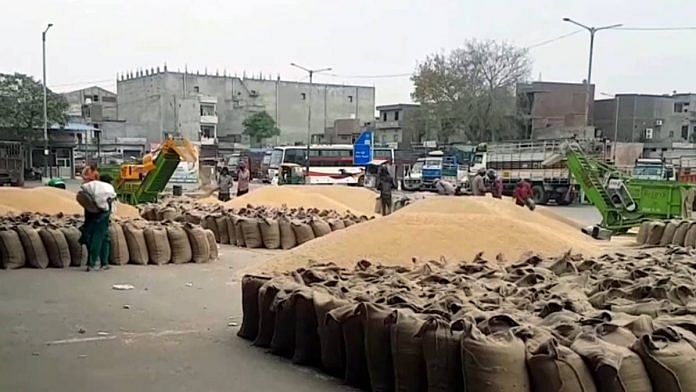New Delhi: Pre-existing orders, impact of the Russia-Ukraine war, and demand from countries that previously did not buy wheat from India — these are the reasons why there has been a growth in wheat export despite a ban on the same, according to sources in the Ministry of Commerce and Industry.
India’s wheat exports doubled between April and August this year as compared to the same period last year, according to commerce ministry data. The Union government had put restrictions on wheat exports in May in order to control rising domestic prices.
“On the face of it, it looks paradoxical, but there are two reasons for the rise in wheat exports compared to last year,” a commerce ministry official explained. “First, there were pre-existing contracts in place before the restrictions on wheat exports were imposed in May. Second, these contracts are of a different calibre.”
The wheat export ban came after India’s retail inflation rose to an 8-year high of 7.79 per cent in April. A severe heat wave in April-May had also singed the country’s wheat crop, reducing yields.
However, the restrictions on wheat exports did not apply to consignments registered before 13 May and to requests made by other nations to the Indian government to meet their food security demands.
According to data available on the commerce ministry website, Indian wheat exports stood at 43.5 lakh metric tonnes (MT) during the April-August period this year. This was double of the 20.07 lakh MT exported in the same period last year.
Even between June and August — the period immediately after the export ban — export figures for wheat were higher than in 2021 — 17.98 lakh MT this year, compared to 13.54 lakh MT in 2021.
The growth is significant since India exported to only a handful of countries in the months following the ban — 11 countries in June, five in July and eight in August, according to the ministry website. In 2021, India exported wheat to 33 countries in June, 34 in July and 33 in August.
India had been a marginal player in the global wheat market last year, but emerged as a key player this year, as the Russia-Ukraine war had created a “global supply crunch”, prompting demand from countries that had not bought Indian wheat in the past, the official quoted earlier said.
Ukraine and Russia, among top global producers of wheat, have witnessed sharp falls in exports of the grain ever since the war began in February.
“So now you can imagine if we hadn’t put restrictions in place. Our exports would have exponentially multiplied,” the commerce ministry official said.
The demand has grown especially from East Asian countries.
For example, according to commerce ministry data, South Korea — which hadn’t imported Indian wheat for the past six years — has been among this year’s top buyers so far, importing 5.04 lakh MT of Indian wheat between April and August alone.
However, while India continues to export to most neighbours facing food security concerns, consignments to Nepal have fallen as compared to last year.
Also read: More bad news after inflation hits 5-month high: Wheat stocks at 6-yr low, ‘rice output to fall’
Rising demand, especially from East Asia
Before the pandemic, India exported just over 2 lakh MT of wheat in the 2019-2020 financial year, according to ministry data. This is about five per cent of the wheat that was exported in the first five months of the current financial year.
“The demand for Indian wheat grew during the pandemic when food security first emerged as a priority for countries across the world, and grew again when the Ukraine conflict began,” said Tarun Bajaj, director of the Agricultural and Processed Food Products Export Development Authority (APEDA) — a trade promotion body under the commerce ministry.
“This year, wheat and rice have become sought-after commodities,” he added.
According to Bajaj, wheat exports have doubled due to government-to-government contracts that were already in place with letters of credit issued before the restrictions were imposed in May.
“We also got market access in countries like Egypt before the restrictions. But mostly, the contracts that have been honoured have been with countries that have regularly imported Indian wheat over the years, like Bangladesh,” said the APEDA director.
An analysis of commerce ministry data shows that over the past year, there has been an exponential growth in exports of Indian wheat to East Asian countries such as Vietnam, Philippines, Thailand, and as mentioned earlier, South Korea, because of the impact of the Russia-Ukraine war.
For example, Vietnam imported just over 4,500 MT of wheat in April-August 2021 compared to about 73,000 MT for the same period this year. The last time Vietnam imported similar amounts of wheat from India was in 2013 (62,000 MT).
Similarly, the Philippines imported 21 MT in April-August 2021, which increased to 1.74 lakh MT during the same period this year. Thailand received over 1,300 MT of Indian wheat in April-August 2021 which has now increased to 2.12 lakh MT for the same period this year.
The curious case of Nepal
While India has eased wheat export restrictions for most of its neighbouring countries with food security concerns, Nepal is not one of them.
Wheat exports to Nepal fell from 1.64 lakh MT in April-August 2021 to just 15,000 MT during the same period this year, according to commerce ministry data.
According to ministry sources, the problem could be that Nepali exports weren’t backed by letters of credit ahead of the ban, or that Nepal didn’t make use of the window of time India provided after the ban, for nations to make government-to-government requests for wheat.
(Edited by Poulomi Banerjee)
Also read: Good news from the farm as India’s FY22 foodgrain production estimated at record 316 mn tonnes



